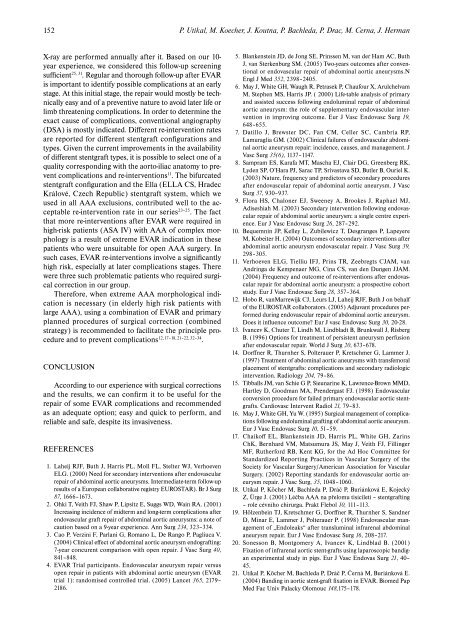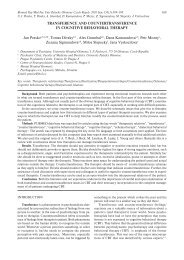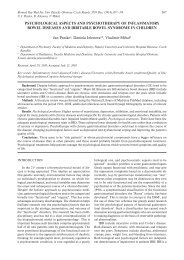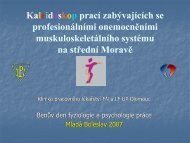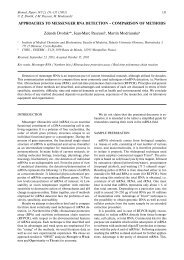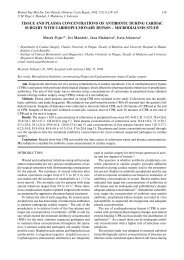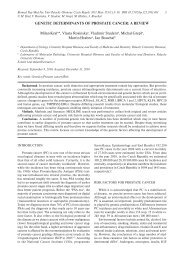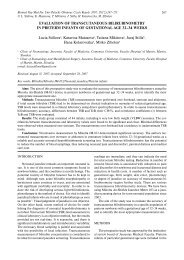SURGICAL CORRECTION OF ENDOVASCULAR ANEURYSMS ...
SURGICAL CORRECTION OF ENDOVASCULAR ANEURYSMS ...
SURGICAL CORRECTION OF ENDOVASCULAR ANEURYSMS ...
Create successful ePaper yourself
Turn your PDF publications into a flip-book with our unique Google optimized e-Paper software.
152 P. Utikal, M. Koecher, J. Koutna, P. Bachleda, P. Drac, M. Cerna, J. HermanX-ray are performed annually after it. Based on our 10-year experience, we considered this follow-up screeningsufficient 25, 31 . Regular and thorough follow-up after EVARis important to identify possible complications at an earlystage. At this initial stage, the repair would mostly be technicallyeasy and of a preventive nature to avoid later life orlimb threatening complications. In order to determine theexact cause of complications, conventional angiography(DSA) is mostly indicated. Different re-intervention ratesare reported for different stentgraft configurations andtypes. Given the current improvements in the availabilityof different stentgraft types, it is possible to select one of aquality corresponding with the aorto-iliac anatomy to preventcomplications and re-interventions 11 . The bifurcatedstentgraft configuration and the Ella (ELLA CS, HradecKrálové, Czech Republic) stentgraft system, which weused in all AAA exclusions, contributed well to the acceptablere-intervention rate in our series 23–25 . The factthat more re-interventions after EVAR were required inhigh-risk patients (ASA IV) with AAA of complex morphologyis a result of extreme EVAR indication in thesepatients who were unsuitable for open AAA surgery. Insuch cases, EVAR re-interventions involve a significantlyhigh risk, especially at later complications stages. Therewere three such problematic patients who required surgicalcorrection in our group.Therefore, when extreme AAA morphological indicationis necessary (in elderly high risk patients withlarge AAA), using a combination of EVAR and primaryplanned procedures of surgical correction (combinedstrategy) is recommended to facilitate the principle procedureand to prevent complications 12, 17–18, 21–22, 32–34 .CONCLUSIONAccording to our experience with surgical correctionsand the results, we can confirm it to be useful for therepair of some EVAR complications and recommendedas an adequate option; easy and quick to perform, andreliable and safe, despite its invasiveness.REFERENCES1. Laheij RJF, Buth J, Harris PL, Moll FL, Stelter WJ, VerhoevenELG. (2000) Need for secondary interventions after endovascularrepair of abdominal aortic aneurysms. Intermediate-term follow-upresults of a European collaborative registry EUROSTAR). Br J Surg87, 1666–1673.2. Ohki T, Veith FJ, Shaw P, Lipsitz E, Suggs WD, Wain RA. (2001)Increasing incidence of midterm and long-term complications afterendovascular graft repair of abdominal aortic aneurysms: a note ofcaution based on a 9-year experience. Ann Surg 234, 323–334.3. Cao P, Verzini F, Parlani G, Romano L, De Rango P, Pagliuca V.(2004) Clinical effect of abdominal aortic aneurysm endografting:7-year concurent comparison with open repair. J Vasc Surg 40,841–848.4. EVAR Trial participants. Endovascular aneurysm repair versusopen repair in patients with abdominal aortic aneurysm (EVARtrial 1): randomised controlled trial. (2005) Lancet 365, 2179–2186.5. Blankenstein JD, de Jong SE, Prinssen M, van der Ham AC, ButhJ, van Sterkenburg SM. (2005) Two-years outcomes after conventionalor endovascular repair of abdominal aortic aneurysms.NEngl J Med 352, 2398–2405.6. May J, White GH, Waugh R, Petrasek P, Chaufour X, ArulchelvamM, Stephen MS, Harris JP. ( 2000) Life-table analysis of primaryand assisted success following endoluminal repair of abdominalaortic aneurysm: the role of supplementary endovascular interventionin improving outcome. Eur J Vasc Endovasc Surg 19,648–655.7. Datillo J, Brewster DC, Fan CM, Celler SC, Cambria RP,Lamuraglia GM. (2002) Clinical failures of endovascular abdominalaortic aneurysm repair: incidence, causes, and management. JVasc Surg 35(6), 1137–1147.8. Sampram ES, Karafa MT, Mascha EJ, Clair DG, Greenberg RK,Lyden SP, O’Hara PJ, Sarac TP, Srivastava SD, Butler B, Ouriel K.(2003) Nature, frequency and predictors of secondary proceduresafter endovascular repair of abdominal aortic aneurysm. J VascSurg 37, 930–937.9. Flora HS, Chaloner EJ, Sweeney A, Brookes J, Raphael MJ,Adiseshiah M. (2003) Secondary intervention following endovascularrepair of abdominal aortic aneurysm: a single centre experience.Eur J Vasc Endovasc Surg 26, 287–292.10. Bequemnin JP, Kelley L, Zubilewicz T, Desgranges P, LapeyereM, Kobeiter H. (2004) Outcomes of secondary interventions afterabdominal aortic aneurysm endovascular repair. J Vasc Surg 39,298–305.11. Verhoeven ELG, Tielliu IFJ, Prins TR, Zeebregts CJAM, vanAndringa de Kempenaer MG, Cina CS, van den Dungen JJAM.(2004) Frequency and outcome of re-interventions after endovascularrepair for abdominal aortic aneurysm: a prospective cohortstudy. Eur J Vasc Endovasc Surg 28, 357–364.12. Hobo R, vanMarrewijk CJ, Leurs LJ, Laheij RJF, Buth J on behalfof the EUROSTAR collaborators. (2005) Adjuvant procedures performedduring endovascular repair of abdominal aortic aneurysm.Does it influence outcome? Eur J vasc Endovasc Surg 30, 20-28.13. Ivancev K, Chuter T, Lindh M, Lindbladt B, Brunkwall J, RisbergB. (1996) Options for treatment of persistent aneurysm perfusionafter endovascular repair. World J Surg 20, 673–678.14. Dorffner R, Thurnher S, Polterauer P, Kretschmer G, Lammer J.(1997) Treatment of abdominal aortic aneurysms with transfemoralplacement of stentgrafts: complications and secondary radiologicintervention. Radiology 204, 79–86.15. Tibballs JM, van Schie G P, Sieunarine K, Lawrence-Brown MMD,Hartley D, Goodman MA, Prendergast FJ. (1998) Endovascularconversion procedure for failed primary endovascular aortic stentgrafts.Cardiovasc Intervent Radiol 21, 79–83.16. May J, White GH, Yu W. (1995) Surgical management of complicationsfollowing endoluminal grafting of abdominal aortic aneurysm.Eur J Vasc Endovasc Surg 10, 51–59.17. Chaikoff EL, Blankenstein JD, Harris PL, White GH, ZarinsChK, Bernhard VM, Matsumura JS, May J, Veith FJ, FillingerMF, Rutherford RB, Kent KG, for the Ad Hoc Committee forStandardized Reporting Practices in Vascular Surgery of theSociety for Vascular Surgery/American Association for VascularSurgery. (2002) Reporting standards for endovascular aortic aneurysmrepair. J Vasc Surg, 35, 1048–1060.18. Utíkal P, Köcher M, Bachleda P, Dráč P, Buriánková E, KojeckýZ, Ürge J. (2001) Léčba AAA na přelomu tisíciletí – stentgrafting– role cévního chirurga. Prakt Flebol 10, 111–113.19. Hölzenbein TJ, Kretschmer G, Dorffner R, Thurnher S, SandnerD, Minar E, Lammer J, Polterauer P. (1998) Endovascular managementof „Endoleaks“ after transluminal infrarenal abdominalaneurysm repair. Eur J Vasc Endovasc Surg 16, 208–217.20. Sonesson B, Montgomery A, Ivancev K, Lindblad B. (2001)Fixation of infrarenal aortic stent-grafts using laparoscopic bandiganexperimental study in pigs. Eur J Vasc Endovas Surg 21, 40–45.21. Utíkal P, Köcher M, Bachleda P, Dráč P, Černá M, Buriánková E.(2004) Banding in aortic stent-graft fixation in EVAR. Biomed PapMed Fac Univ Palacky Olomouc 148,175–178.


